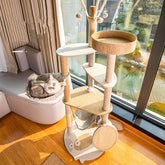Creating a Safe Emotional Environment for Your Cat: Understanding Their Needs and Nurturing Their Well-Being
Table of Contents
- Key Highlights:
- Introduction
- Understanding Feline Emotions
- Creating Consistent Routines
- Providing Safe Spaces
- Encouraging Gentle Socialization
- Minimizing Stressful Triggers
- Building Trust Through Positive Reinforcement
- Respecting Your Cat’s Unique Personality
Key Highlights:
- Cats exhibit subtle emotional signals, indicating their happiness, anxiety, or fear through behaviors like tail movements and purring.
- Establishing consistent routines helps cats feel stable and secure, reducing stress in their environment.
- Providing safe spaces and encouraging gentle socialization can significantly enhance a cat's emotional well-being.
Introduction
For countless cat owners, the bond between human and feline is enriched by a shared desire for emotional understanding and comfort. Although cats are often seen as solitary creatures, their emotional landscape is intricate and deeply personal. Many cat owners may not realize that their pets experience a broad range of emotions similar to our own. From joy and contentment to fear and anxiety, recognizing these feelings is critical for nurturing their overall happiness. Creating an environment that respects and cherishes a cat's emotional needs is paramount in fostering a healthy, fulfilling life for these beloved companions.
This article delves into various aspects of feline emotions, exploring practical strategies to enhance the emotional well-being of your cat. By understanding their unique perspectives and behaviors, you can cultivate a nurturing home that promotes safety and affection.
Understanding Feline Emotions
Cats, with their enigmatic nature and renowned independence, possess a profound emotional world that often goes unnoticed. Unlike dogs, whose emotions may be more overtly expressed, cats reveal their feelings in subtler ways. A twitch of the tail, a slow blink, or a contented purr can convey a wealth of information about their state of mind.
For instance, when a cat flattens its ears, it may be feeling threatened. Conversely, a cat that purrs while napping next to you is comfortable and trusts your presence. Furthermore, understanding these signals is essential for interpreting your cat's emotional state. A cat frequently hiding or displaying reluctance to engage in play likely feels anxious or insecure, requiring supportive intervention to help them regain their confidence.
Recognizing the importance of emotional health in cats reshapes our perception of their needs. Just as we thrive in a supportive environment, empathizing with the emotional experiences of our feline friends can significantly enhance their quality of life. Engaging with them through gentle interaction fosters emotional expression and deepens the bond between owner and pet.
Creating Consistent Routines
Cats flourish in environments characterized by stability and predictability. Sudden changes in their surroundings can trigger feelings of anxiety and uncertainty. Implementing consistent routines around feeding, playtime, and bedtime creates a stable framework that allows your cat to feel secure in their daily life.
Much like humans, cats benefit from knowing what to expect. Regular feeding schedules not only enhance their physical health but also provide emotional comfort. Picture how unsettling unexpected changes can be; for cats, even minor disruptions—like rearranging furniture or introducing new people—can cause considerable stress.
Establishing a daily routine acts as an invisible embrace, reassuring cats that their world is safe and trustworthy. This stability is vital for their emotional health and well-being. By taking care to maintain predictable patterns, you affirm your role as a source of safety, reinforcing your cat's trust in their living environment.
Providing Safe Spaces
Central to feline emotional well-being is the availability of safe spaces. Every cat requires a sanctuary where they can retreat and feel entirely secure. This could manifest as a cozy bed in a quiet corner, a gentle hideaway within a box, or a high perch that offers a view of their surroundings while ensuring safety.
Creating these private retreats is instrumental for your feline. Cats sometimes experience overwhelming emotions, and the assurance of a safe haven allows them to decompress and regain composure. It is crucial not to intrude upon these spaces when your cat seeks solitude; doing so can undermine their sense of trust.
Personalizing these sanctuaries with your cat's favorite toys or blankets serves to further enhance their comfort. Such thoughtful spaces are direct reflections of your care and understanding of their need for emotional security. This practice not only respects their boundaries but also conveys your appreciation for their unique nature.
Encouraging Gentle Socialization
Cats are inherently curious creatures, but they tend to approach new individuals or situations with caution. Understanding the pace at which your cat is comfortable socializing is vital for reducing stress and building trust. Avoid using force or overwhelming your cat with attention; instead, allow them to dictate the terms of interaction.
Gentle encouragement can include simply sitting quietly in the same room or offering treats in a relaxed manner. Young children and visitors should be educated about respecting the cat's boundaries so as not to create an environment of fear or discomfort.
Each cat embodies its personality traits, and while some may enjoy socializing and playing with multiple people, others thrive in calmer settings with less interaction. Acknowledging and respecting these differences fosters a sense of emotional security, leading to a healthier, more relaxed pet.
Minimizing Stressful Triggers
Observant cat owners understand that the external world can be daunting for their sensitive companions. Loud noises, sudden movements, or the introduction of new household dynamics can easily provoke anxiety. Identifying and addressing these triggers is essential for managing your cat’s emotional health effectively.
Recognizing what instills fear in your cat—be it the sound of a vacuum cleaner or the arrival of a new pet—allows for proactive measures to minimize those stressors. Simple solutions may include employing calming pheromone diffusers, providing soothing background noise, or gradually exposing your cat to new stimuli.
Your presence during tense moments can reassures your cat, reinforcing the idea that they are safeguarded and valued. By actively working to mitigate sources of stress, you not only enhance their emotional well-being but also build a deeper bond rooted in trust and protection.
Building Trust Through Positive Reinforcement
Trust forms the foundation of a cat’s emotional security. Rather than utilizing punishment for undesirable behavior, focusing on positive reinforcement strengthens the bond between owner and pet. Rewarding your cat for desirable actions—such as rewarding them when they choose the scratching post over the couch—enhances their learning experience while fostering feelings of safety.
Positive interactions, whether through treats, praise, or gentle petting, encourage cats to associate their human with joy and comfort. By consistently providing positive feedback, you cultivate an environment where your cat can flourish emotionally. Approaching cats with patience and understanding is key; they are keenly aware of how they are treated, especially during vulnerable moments.
The cumulative effect of such nurturing behavior builds a lifelong trust that enhances the overall quality of life for your cat. This positive reinforcement encourages them to express themselves more freely, allowing for a deep and lasting bond that enriches both lives.
Respecting Your Cat’s Unique Personality
Recognizing and respecting the individuality of your cat is crucial in creating an environment where they feel permanently secure and cherished. Just as humans possess unique traits and personalities, so do cats. While some cats may thrive on interactive play, others may prefer quieter, more solitary experiences.
Imposing interaction on a shy or reserved cat can breed frustration and diminish their confidence. Instead, celebrate their idiosyncrasies, giving them space to express their true selves. Whether your cat is lively or laid-back, accepting them for who they are enhances their emotional health and allows them to feel loved unconditionally.
Creating an environment that respects and accommodates the distinct personality of your cat is a vital aspect of nurturing their emotional safety. By doing so, you enable your cat to thrive in a loving atmosphere that reflects their unique spirit and individuality.
FAQ
What signs indicate that my cat is stressed? Signs of stress in cats include hiding, excessive grooming, aggression, and changes in appetite or litter box habits.
How can I help my cat adjust to a new environment? Providing a safe space, maintaining a consistent routine, and allowing gradual exposure to new stimuli can help your cat acclimate.
Is it okay to discipline my cat? Instead of discipline, focus on redirecting unwanted behavior and using positive reinforcement to create a trusting relationship.
How can I improve my cat's socialization? Encourage gentle socialization by allowing the cat to approach new people or pets at their own pace and rewarding them for calm interactions.
What can I do if my cat seems fearful or anxious? Identify stress triggers and work to minimize them. Create calm environments, employ soothing techniques, and ensure your cat has safe spaces.
By understanding these principles of feline emotional health, cat owners can cultivate a nurturing atmosphere that promotes lasting security and happiness for their treasured companions.





